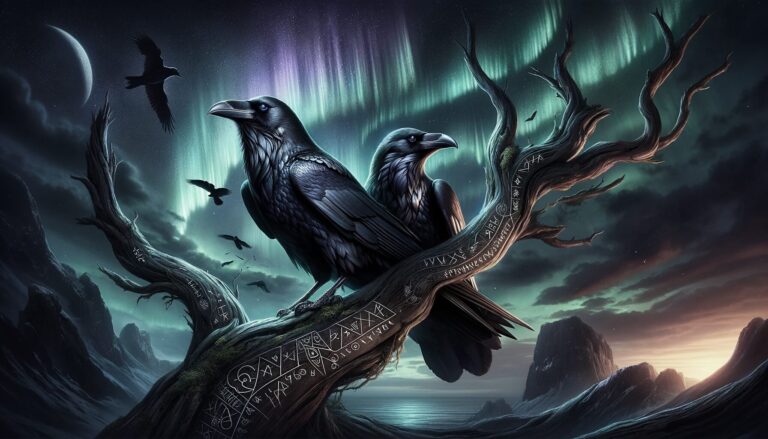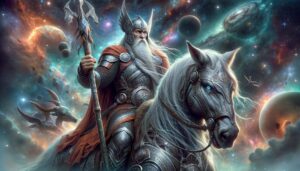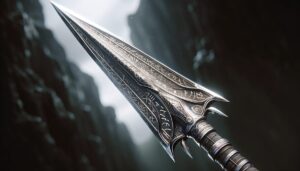Table of Contents
Whether presiding over a grand banquet or galloping into the fearsome battle of Ragnarök, Odin always has Huginn and Muninn attending him. These powerful ravens are more than servants; day after day, battle after battle, they prove themselves as trusted allies and inseparable friends.
In Norse mythology, Huginn and Muninn are a pair of ravens enlisted in Odin’s service. Every morning at dawn, they depart to fly around Midgard, the Norse world. At dinner, they return to their perches on Odin’s shoulders, recounting what they have seen.
Appearance and powers
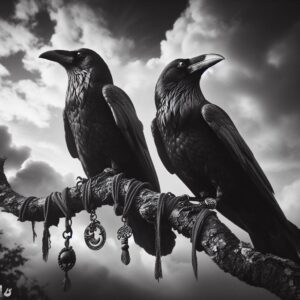
Huginn and Muninn, resembling ordinary ravens, boast inky black feathers and formidable beaks. Their wings, powerful and expansive, propel them high above, granting a panoramic view of the landscape below.
Gifted by Odin, these seemingly mundane birds possess extraordinary abilities. First, their wings carry them across the entirety of Midgard within a single day. Second, they grasp the language of men, articulating thoughts with human tongues. Third, their minds are sharp, observant, and shrewd.
In the vast realm of Midgard, Huginn and Muninn extend beyond being mere spies; they are invaluable advisors to Odin. Transitioning into battle, the ravens accompany Odin, serving as vigilant informants. They reveal the intricacies of the enemy’s movements, aiding Odin in strategic guidance.
During the chaos of battle, the ravens prove instrumental. They not only decipher the unfolding events but also contribute to Odin’s prowess by guiding and tending to his steed. In the midst of conflict, Huginn and Muninn stand not as mere spectators but as active participants, elevating their role from observers to indispensable allies.
As Odin maneuvers through the battlefield, the ravens fulfill a dual purpose—informing and assisting, embodying the symbiotic relationship between deity and winged confidants. In the realm of gods and men, Huginn and Muninn transcend the ordinary, their black wings carrying whispers of wisdom and strategy.
Relationship with Odin
Some scholars argue that Huginn and Muninn are Odin’s projections, extensions of his consciousness. Transitioning to Norse traditions, shamans entered trances to explore the world.
Huginn, meaning “thought,” and Muninn, meaning “desire,” reinforce the idea of conscious projections. Odin, as the godly leader, could project his thoughts symbolically through ravens.
Others propose that Huginn and Muninn are Odin’s fylgjur—spirit animals embodying his character. In Norse belief, ravens represent wisdom, aligning with Odin’s role as a wise guide.
Fylgjur connect to fate; appearing before climactic events, they foretell and accompany pivotal moments. Huginn and Muninn notably warn of Ragnarök, signaling Odin’s impending doom.
In a different perspective, some scholars see the ravens as Odin’s hamingja, representing his luck. Norse spirits comprise various parts; the hamingja, less essential, embarks on minor missions for the greater spirit.
Whether projections, fylgjur, or hamingja, Huginn and Muninn’s significance transcends mere symbolism. They embody Odin’s consciousness, character, and luck, entwined with fate and pivotal moments in Norse mythology.
History
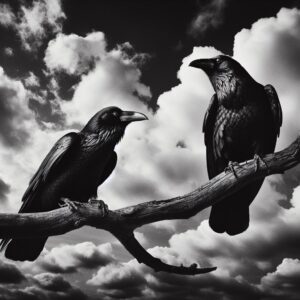
Archaeological Record
In the vast expanse of archaeological digs, ravens emerge as enduring symbols of Norse culture. Across nine centuries and four countries, they assert their dominance, adorning artifacts with golden elegance. Amulets, helmet plates, and shoulder brooches from the fifth to seventh centuries all feature these majestic birds.
On the Oserberg Tapestry, a relic from a ninth-century Viking funeral ship, ravens gracefully weave through the fabric, leaving an indelible mark on history. Thorwald’s Cross, an eleventh-century runic stone, stands as another testament to their prominence, with ravens perched as silent sentinels. Throughout Sweden, Denmark, Norway, and even England, the archaeological record resonates with the invocation of Huginn and Muninn.
As Odin’s loyal companions, these ravens soar across the ages, their wings whispering secrets to those who seek power and guidance. In the silent echoes of the past, they embody a connection between the tangible artifacts and the ethereal realm of Norse mythology. The archaeological tapestry unfolds, revealing a cultural legacy intricately woven with the threads of these enigmatic birds.
In golden splendor, the ravens transcend time, eternally vigilant as symbols of wisdom and insight. Transitioning through the archaeological landscape, their presence is a constant reminder of the ancient bond forged between humanity and the mysterious allure of the Norse cosmos.
Explanation of the Myth
Huginn and Muninn, formidable ravens, find their roots in Norse culture, a profound connection forged through practicality and symbiosis. These avian companions, powerful symbols in Norse folklore, transcended myth to become integral to everyday life.
In the ancient Norse landscape, a primitive alliance formed between humans and ravens, a mutual reliance shaped by shared sustenance. The clever ravens, drawn to the hunters’ kills, and the hungry hunters, following the circling ravens to ready meals, established a bond woven in the fabric of survival.
As Norse civilization evolved, ravens sailed the seas alongside their human allies, guiding Viking ships to distant lands. Caged on ships, these mighty birds were released into the sea breeze to scout the surroundings. If land awaited, they soared towards it; if not, they returned to the ship, their avian wisdom aiding the seafaring Norse.
Transitioning through time, ravens evolved from scavengers to trusted navigators, earning reverence from the Norse people. Guiding countless seekers to sustenance and safety, these black-winged creatures ascended to Odin’s shoulders, a testament to the profound role they played in shaping the destiny of a culture.
FAQ
What do the names Huginn and Muninn mean?
Huginn translates to "thought," and Muninn translates to "memory" or "mind." Together, they represent the mental faculties and intelligence.
What is the role of Huginn and Muninn in Norse mythology?
Huginn and Muninn fly throughout the world to gather information for Odin. They serve as his eyes and ears, bringing him knowledge from various realms.
How are Huginn and Muninn portrayed in Norse art and literature?
In art, they are often depicted perched on Odin's shoulders. In literature, they appear in various sagas and poems, symbolizing Odin's quest for knowledge.
What is the significance of ravens in Norse culture?
Ravens were seen as symbols of intelligence, guidance, and connection between the earthly and divine realms. They played practical roles, such as guiding Viking ships.
Are Huginn and Muninn mentioned in specific Norse myths?
While they don't have a standalone myth, they are referenced in various Norse poems, including the Poetic Edda, where their journeys are briefly described.
Do Huginn and Muninn have distinctive characteristics or traits?
Huginn is associated with rational thought, while Muninn is linked to memory. Together, they embody the qualities of insight and knowledge.
How did Norse people view the relationship between Odin and Huginn/Muninn?
The Norse regarded the ravens as valuable companions to Odin, embodying the pursuit of wisdom and the connection between the divine and mortal realms.
Are there modern interpretations or references to Huginn and Muninn?
Yes, Huginn and Muninn continue to appear in literature, art, and popular culture, symbolizing wisdom, foresight, and the pursuit of knowledge.
Can individuals connect with the symbolism of Huginn and Muninn today?
Absolutely. The ravens' symbolism of thought and memory can inspire individuals to seek knowledge, embrace wisdom, and trust their inner guidance.
